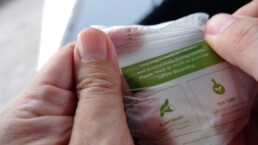Do you know what Bioplastics are? Bioplastics are an increasingly popular sustainable alternative to traditional plastics. Coming from natural sources, they have characteristics comparable to those of normal plastics used in production processes, but have a reduced environmental impact.
Due to its features, this type of material allows for quite wide applications, including innovative sectors such as medical, 3D printing and green technologies.
What are bioplastics?
To better understand the definition of bioplastics, let us start with their origin. These are polymers produced using biodegradable or renewable raw materials, such as corn starch, sugar cane, potatoes or algae.
Bioplastics are less harmful to the environment and contribute to the reduction of CO2 emissions. Plus, of course, they reduce the production, use and consumption of plastic globally. Let us take a look at their main characteristics:
- Biodegradability: bioplastics decompose spontaneously through biological processes. Therefore, they do not contribute to the accumulation of plastic waste in the environment. In addition, they can be disposed of in a more sustainable way.
- Production from renewable raw materials: bioplastics are produced using plant-based raw materials that can be grown again and thus are available on a long-term basis.
- Reduction of CO2 emissions: in their production process, bioplastics generate far less CO2 than petroleum-derived plastics.
- Flexibility: bioplastics have different properties. Rigidity, elasticity or resistance, for example, are more or less common characteristics depending on the requirements of use.
Therefore, bioplastics represent a sustainable and innovative solution for the production of plastic materials. In the next section, we will talk about their applications and the advantages and disadvantages of their use.
Bioplastics: examples, disadvantages and advantages
Presenting some examples of bioplastics and some of their applications is the best way to explain what they are and why they are growing in popularity. Among the best-known types are:
- Polylactic acid (PLA), a bioplastic made from corn starch used to produce bottles, food packaging, caps and containers;
- Green polyethylene, derived from sugar cane, it is used for bags, films and containers;
- Polyhydroxyalkanoates (PHA), bioplastics made from vegetable oils and sugars, which find application in areas such as packaging, medicine, cosmetics and agriculture;
- Polybutylene succinate (PBS), used to produce biodegradable bags, films and packaging materials;
- Polycaprolactone (PCL), that finds application in packaging and 3D printing. It is also used for medical applications, e.g. for resorbable sutures;
- Mater-Bi, 100% compostable, is used to produce shopping bags, packaging and protective films and disposable tableware.
We have already talked about the main benefits of bioplastics in terms of sustainability, versatility and their use in highly innovative sectors.
The disadvantages, on the other hand have to do mainly with three elements:
- availability of raw materials, that is large-scale production of bioplastics requires a significant amount of plant raw materials;
- complex production processes, due to the expensive chemical and biotechnological processes for the transformation of green raw materials into bioplastics;
- composting, since some bioplastics need a controlled environment to degrade properly.
However, more and more companies are using this type of material in plastics processing. To meet their needs, Vismec has developed specific technologies and machinery.
Vismec equipment for the bioplastics sector
Our company offers a line of dryers designed specifically for all those materials that, due to their characteristics, must be treated at temperatures between 35°C and 50°C.
This innovation is dedicated to specific sectors, which we are going to examine right now.
- The bioplastics field which we are talking about this article: biological polymers that cannot be dehumidified at high temperatures. In fact, during the process, this type of material could melt or undergo degradation that would alter its characteristics and functionality.
- Materials that, subjected to high temperatures, release oils or volatile substances with a negative impact on the end result of the process.
Our low-temperature dehumidifiers work in a similar way to Vismec rotor dryers. However, to each dehumidifier we add an air/air heat exchanger located before the heating chamber. This includes a series of fans that lower the temperature of the air used to dehumidify the plastic granules.
Available in different sizes and integrable with additional accessories, our low-temperature dryers are reliable, versatile and efficient.
Would you like to know more about the features of Vismec’s equipment offered to companies in the bioplastics sector? Contact us: our technicians will provide you with all the necessary specifications.
